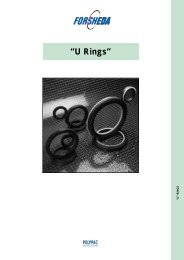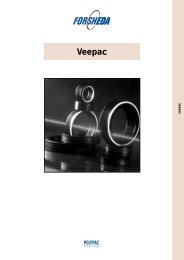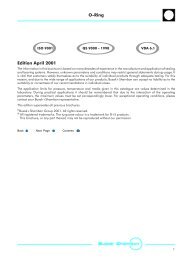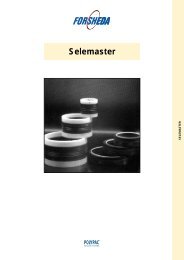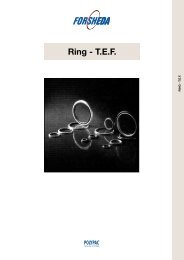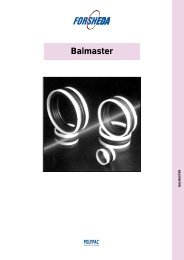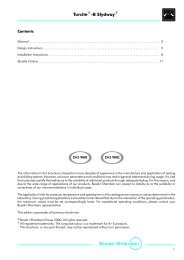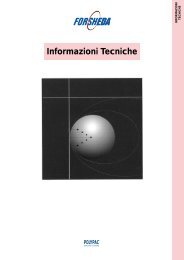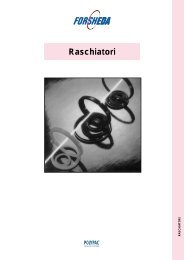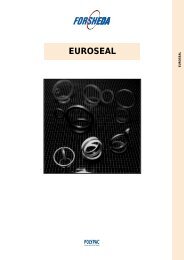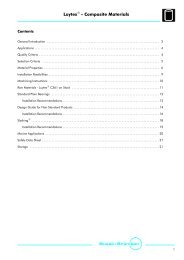Rotary Seals - Dilanda.it
Rotary Seals - Dilanda.it
Rotary Seals - Dilanda.it
Create successful ePaper yourself
Turn your PDF publications into a flip-book with our unique Google optimized e-Paper software.
V—Ring<br />
n V-RING<br />
n General<br />
minimum, resulting in excellent wear characteristics and<br />
extended seal life. Once breakaway friction is overcome,<br />
the friction reduce steadily until around the 10 - 15 m/s<br />
range, when <strong>it</strong> reduces qu<strong>it</strong>e quickly. In the 15 - 20 m/s<br />
range the friction reduces to zero. The V—Ring then serves<br />
as a clearance seal and deflector. The power loss due to seal<br />
friction develops as shown in Fig. 54.<br />
The flexible lip and hinge allow the V—Ring to function even<br />
in the presence of a certain amount of run-out, eccentric<strong>it</strong>y<br />
and shaft misalignment. Contact our local B+S company for<br />
advice on these and other application issues.<br />
V—Rings are made entirely of rubber w<strong>it</strong>hout fabric or sheet<br />
metal reinforcement. They are, therefore, particularly easy<br />
to install. V—Rings can be stretched and, depending on size,<br />
installed over flanges, pulleys and bearing housings<br />
w<strong>it</strong>hout costly dismantling. For larger sizes they can even<br />
be supplied as cut rings and joined by vulcanisation on s<strong>it</strong>e.<br />
Figure 53<br />
Method of operation of the V—Ring<br />
The V-RING is a unique all-rubber seal for rotary shafts.<br />
Developed in the 1960’s by FORSHEDA AB, <strong>it</strong> has been used<br />
successfully by OEMs and on the replacement market world<br />
wide in a broad range of applications.<br />
The V—Ring is the perfect seal to prevent the ingress of dirt,<br />
dust, water or combinations of these media while<br />
pos<strong>it</strong>ively retaining grease. W<strong>it</strong>h <strong>it</strong>s unique design and<br />
performance the V—Ring can be used w<strong>it</strong>h a wide range of<br />
bearing types. It can also be used as a secondary seal to<br />
protect primary seals that do not perform well in hostile<br />
environments.<br />
Description and advantages<br />
The V—Ring is normally stretched and mounted directly on<br />
the shaft, where <strong>it</strong> is held in pos<strong>it</strong>ion by the inherent<br />
tension of the rubber body. It rotates w<strong>it</strong>h the shaft and<br />
seals axially against a stationary counterface, perpendicular<br />
to the shaft. The counterface can be the side wall of a<br />
bearing or a washer, stamping, bearing housing, or even<br />
the metal case of an oil seal. The sealing lip is flexible and<br />
applies only a relatively light contact pressure against the<br />
counter-face and yet is still sufficient to maintain the<br />
sealing function. The low contact pressure (that varies w<strong>it</strong>h<br />
the f<strong>it</strong>ted width) allows the seal to run dry in many<br />
applications.<br />
Due to influence of the centrifugal force, the contact<br />
pressure of the lip decreases w<strong>it</strong>h increased speed. This<br />
means that frictional losses and heat are kept to a<br />
Design<br />
V—Rings are available in seven standard cross-sections to<br />
meet various space and application requirements.<br />
The cross-sections of profiles A and S increase w<strong>it</strong>h the<br />
shaft diameter, whilst the other types have the same crosssection<br />
for the whole diameter range.<br />
Profile A is the most common and available for shaft<br />
diameters from 2.7 to 2020 mm, inclusive.<br />
Profile S is wide and tapered, which provides a very firm<br />
hold on the shaft. The rings are available for shaft<br />
diameters from 4.5 to 210 mm.<br />
Profiles L and LX have narrow axial cross sections making<br />
them su<strong>it</strong>able for compact arrangements and are often<br />
used in combination w<strong>it</strong>h labyrinth seals. Available for<br />
shaft diameters from 105 (135 for LX) to 2025 mm.<br />
Profiles RME, RM and AX are heavy duty V—Rings that are<br />
designed primarily for large high speed bearing<br />
arrangements, I. E. rolling mill and papermaking machine<br />
applications. Add<strong>it</strong>ionally they can be used as secondary<br />
seals for heavy duty applications where the primary seal<br />
has to be protected against water and or particulate<br />
contamination. The RME, RM and AX types can be axially<br />
and radially located on the shaft w<strong>it</strong>h the especially<br />
designed clamping bands (see page 149). Available for<br />
shaft diameters from 300 mm and up.<br />
Larger V—Ring sizes are available as spliced seals. For more<br />
details please contact your local B+S company.<br />
144<br />
Latest information available at www.busakshamban.com<br />
Ed<strong>it</strong>ion April 2006



